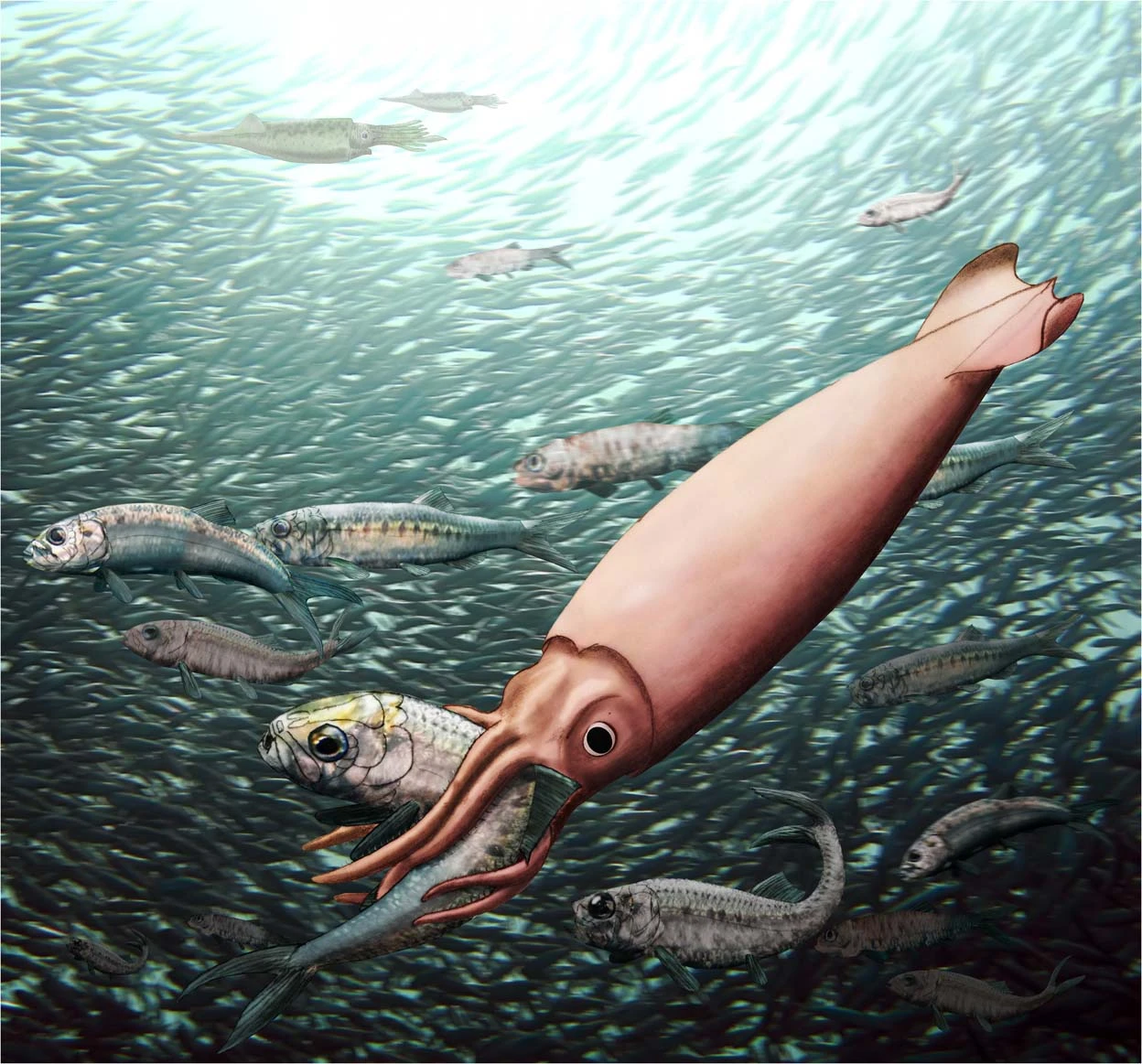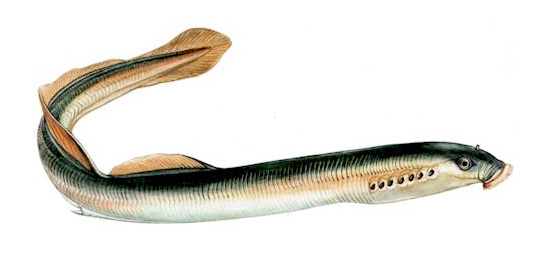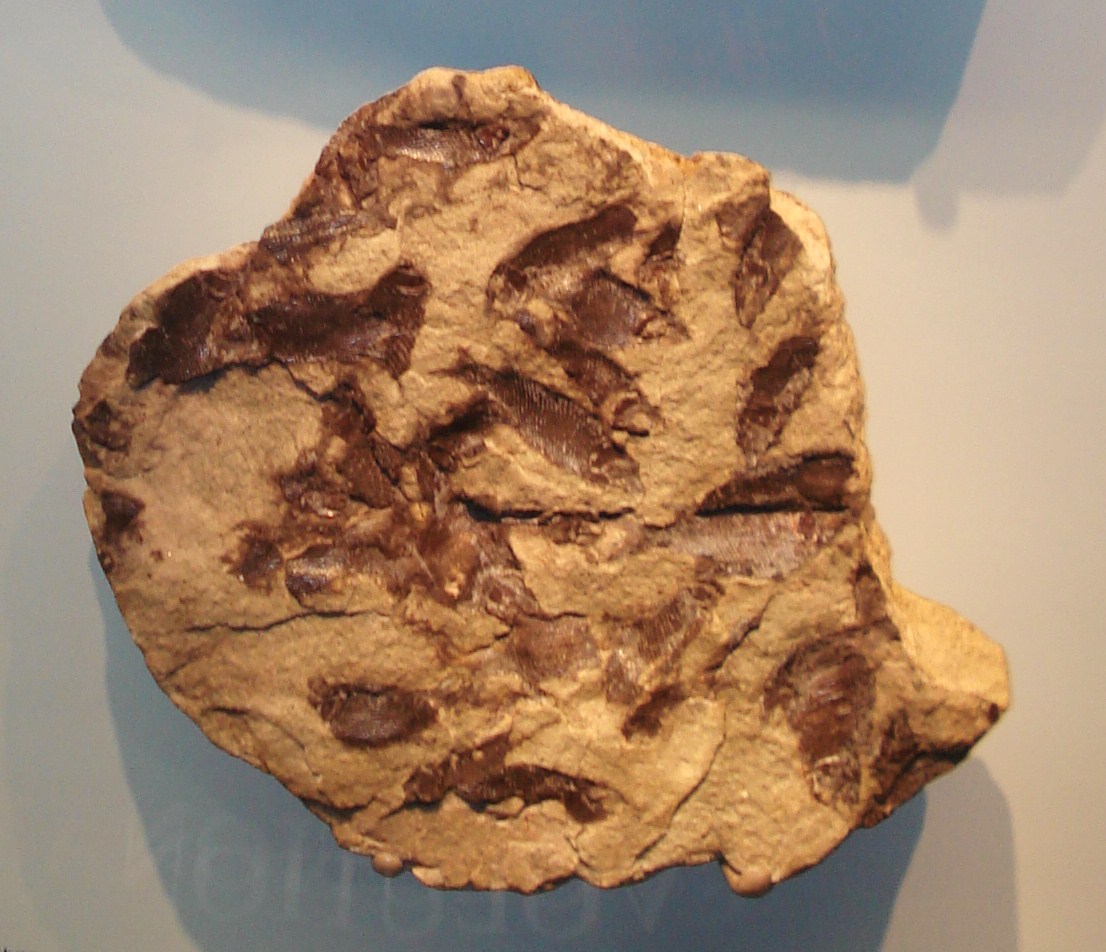|
Kyphosichthys
''Kyphosichthys'' is an extinct genus of basal actinopterygian bony fish known from the lower Middle Triassic (Anisian) marine deposits (Guanling Formation) in Luoping, eastern Yunnan Province, southwestern China. The species is the first known fossil record of highly deep-bodied ginglymodians. Description ''Kyphosichthys'' (Greek for "bent fish") has a strongly arched hump between the head and the dorsal fin, from which its name derives. The holotype measures 96 mm in total length, and 76 mm in standard length. The greatest body height occurs at the posterior opercular margin, where the body height is over 70% of the standard length. The dorsal fin and anal fin are located far back on the body, the latter is only half as long as the dorsal fin. The pelvic fins are much smaller than the pectoral fins. The forked caudal fin is hemi-heterocercal due to a heavy lobe extending into the dorsal lobe of the fin, but outwardly is nearly symmetrical. The body is covered in ... [...More Info...] [...Related Items...] OR: [Wikipedia] [Google] [Baidu] |
Guanling Formation
The Guanling Formation is a Middle Triassic (Anisian or Pelsonian in the regional chronostratigraphy) geologic formation in southwestern China. Description The formation encompasses two members. The first member is primarily calcareous mudstone and dolomite, indicative of a coastal environment. The second member is a thicker marine sequence of dark micritic limestone with some dolomite. Two distinct fossil assemblages are found in the second member. The older Luoping biota preserves abundant arthropods along with fossils from other invertebrates and vertebrates, which are rare but well-preserved. The slightly younger Panxian fauna has a more diverse and common assortment of marine reptiles such as sauropterygians. Fossil content Among others, the following fossils were reported from the formation: * '' Atopodentatus'' * '' Barracudasauroides'' * '' Diandongosaurus'' * '' Dianopachysaurus'' * '' Honghesaurus'' * '' Kyphosichthys'' * '' Largocephalosaurus'' * '' Luopingo ... [...More Info...] [...Related Items...] OR: [Wikipedia] [Google] [Baidu] |
Middle Triassic
In the geologic timescale, the Middle Triassic is the second of three epochs of the Triassic period or the middle of three series in which the Triassic system is divided in chronostratigraphy. The Middle Triassic spans the time between Ma and Ma (million years ago). It is preceded by the Early Triassic Epoch and followed by the Late Triassic Epoch. The Middle Triassic is divided into the Anisian and Ladinian ages or stages. Formerly the middle series in the Triassic was also known as Muschelkalk. This name is now only used for a specific unit of rock strata with approximately Middle Triassic age, found in western Europe. Middle Triassic fauna Following the Permian–Triassic extinction event, the most devastating of all mass-extinctions, life recovered slowly. In the Middle Triassic, many groups of organisms reached higher diversity again, such as the marine reptiles (e.g. ichthyosaurs, sauropterygians, thallatosaurs), ray-finned fish and many invertebrate groups li ... [...More Info...] [...Related Items...] OR: [Wikipedia] [Google] [Baidu] |
Caudal Fin
Fins are distinctive anatomical features composed of bony spines or rays protruding from the body of a fish. They are covered with skin and joined together either in a webbed fashion, as seen in most bony fish, or similar to a flipper, as seen in sharks. Apart from the tail or caudal fin, fish fins have no direct connection with the spine and are supported only by muscles. Their principal function is to help the fish swim. Fins located in different places on the fish serve different purposes such as moving forward, turning, keeping an upright position or stopping. Most fish use fins when swimming, flying fish use pectoral fins for gliding, and frogfish use them for crawling. Fins can also be used for other purposes; male sharks and mosquitofish use a modified fin to deliver sperm, thresher sharks use their caudal fin to stun prey, reef stonefish have spines in their dorsal fins that inject venom, anglerfish use the first spine of their dorsal fin like a fishing rod ... [...More Info...] [...Related Items...] OR: [Wikipedia] [Google] [Baidu] |
Leptolepis
''Leptolepis'' (from el, λεπτός , 'slight' and el, λεπίς 'scale') is an extinct genus of stem-teleost fish that lived in what is now Europe during the Jurassic period (Toarcian–Callovian ages). Species The genus ''Leptolepis'' was for a long time used as a wastebasket taxon for various small, unspecialised teleosts that did not form a natural clade. In 1974 the Swedish ichthyologist Orvar Nybelin revised the genus, restricting it to seven species from the Early to Middle Jurassic of Europe. Other species were reassigned to different genera. * ''Leptolepis autissiodorensis'' * ''Leptolepis coryphaenoides'' * ''Leptolepis jaegeri'' * ''Leptolepis nathorsti'' * ''Leptolepis normandica'' * ''Leptolepis saltviciensis'' * ''Leptolepis woodwardi'' Species formerly placed in ''Leptolepis'' * ''Leptolepis talbragarensis'' (Now referred to ''Cavenderichthys'') * ''Leptolepis koonwarri'' (Now referred to '' Waldmanichthys'')Sferco, Emilia, Adriana López-Arb ... [...More Info...] [...Related Items...] OR: [Wikipedia] [Google] [Baidu] |
Teleostei
Teleostei (; Greek ''teleios'' "complete" + ''osteon'' "bone"), members of which are known as teleosts ), is, by far, the largest infraclass in the class Actinopterygii, the ray-finned fishes, containing 96% of all extant species of fish. Teleosts are arranged into about 40 orders and 448 families. Over 26,000 species have been described. Teleosts range from giant oarfish measuring or more, and ocean sunfish weighing over , to the minute male anglerfish ''Photocorynus spiniceps'', just long. Including not only torpedo-shaped fish built for speed, teleosts can be flattened vertically or horizontally, be elongated cylinders or take specialised shapes as in anglerfish and seahorses. The difference between teleosts and other bony fish lies mainly in their jaw bones; teleosts have a movable premaxilla and corresponding modifications in the jaw musculature which make it possible for them to protrude their jaws outwards from the mouth. This is of great advantage, enabling them ... [...More Info...] [...Related Items...] OR: [Wikipedia] [Google] [Baidu] |
Neopterygii
Neopterygii (from Greek νέος ''neos'' 'new' and πτέρυξ ''pteryx'' 'fin') is a subclass of ray-finned fish (Actinopterygii). Neopterygii includes the Holostei and the Teleostei, of which the latter comprise the vast majority of extant fishes, and over half of all living vertebrate species. While living holosteans include only freshwater taxa, teleosts are diverse in both freshwater and marine environments. Many new species of teleosts are scientifically described each year. Fossil evidence for crown group neopterygians goes back at least 251 million years to the Induan stage of the Early Triassic epoch, however, one study incorporating morphological data from fossils and molecular data from nuclear and mitochondrial DNA, places this divergence date at least 284 mya (million years ago), during the Artinskian stage of the Early Permian. Another study suggests an even earlier split (360 myr ago, near the Devonian-Carboniferous boundary). Evolution and diversity L ... [...More Info...] [...Related Items...] OR: [Wikipedia] [Google] [Baidu] |
Semionotus
''Semionotus'' (from el, σημιον , 'mark' and el, νῶτος , 'back') is an extinct genus of ray-finned fish found throughout Northern Pangaea ( North America and Europe) during the late Triassic, becoming extinct in the Early Jurassic The Jurassic ( ) is a geologic period and stratigraphic system that spanned from the end of the Triassic Period million years ago (Mya) to the beginning of the Cretaceous Period, approximately Mya. The Jurassic constitutes the middle period of .... References External links''"Semionotus elegans"''-Photo-High Res--''"Shuttle Meadow Formation"''-Hartford Basin, Connecticut – www.sunstar-solutions.com–"Basal Jurassic Dinosaur Fossils" Semionotiformes [...More Info...] [...Related Items...] OR: [Wikipedia] [Google] [Baidu] |
Polytomy
An internal node of a phylogenetic tree is described as a polytomy or multifurcation if (i) it is in a rooted tree and is linked to three or more child subtrees or (ii) it is in an unrooted tree and is attached to four or more branches. A tree that contains any multifurcations can be described as a multifurcating tree. Soft polytomies vs. hard polytomies Two types of polytomies are recognised, soft and hard polytomies. Soft polytomies are the result of insufficient phylogenetic information: though the lineages diverged at different times – meaning that some of these lineages are closer relatives than others, and the available data does not allow recognition of this. Most polytomies are soft, meaning that they would be resolved into a typical tree of dichotomies if better data were available. In contrast, a hard polytomy represents a true divergence event of three or more lineages. Applications Interpretations for a polytomy depend on the individuals, that are represe ... [...More Info...] [...Related Items...] OR: [Wikipedia] [Google] [Baidu] |
Mesozoic
The Mesozoic Era ( ), also called the Age of Reptiles, the Age of Conifers, and colloquially as the Age of the Dinosaurs is the second-to-last era of Earth's geological history, lasting from about , comprising the Triassic, Jurassic and Cretaceous Periods. It is characterized by the dominance of archosaurian reptiles, like the dinosaurs; an abundance of conifers and ferns; a hot greenhouse climate; and the tectonic break-up of Pangaea. The Mesozoic is the middle of the three eras since complex life evolved: the Paleozoic, the Mesozoic, and the Cenozoic. The era began in the wake of the Permian–Triassic extinction event, the largest well-documented mass extinction in Earth's history, and ended with the Cretaceous–Paleogene extinction event, another mass extinction whose victims included the non-avian dinosaurs, pterosaurs, mosasaurs, and plesiosaurs. The Mesozoic was a time of significant tectonic, climatic, and evolutionary activity. The era witnessed the gradual ... [...More Info...] [...Related Items...] OR: [Wikipedia] [Google] [Baidu] |
Holostei
Holostei is a group of ray-finned bony fish. It is divided into two major clades, the Halecomorphi, represented by a single living species, the bowfin ('' Amia calva''), as well as the Ginglymodi, the sole living representatives being the gars (Lepisosteidae), represented by seven living species in two genera ('' Atractosteus'', '' Lepisosteus''). The earliest members of the clade appeared during the Early Triassic, over 250 million years ago. Holostei was thought to be regarded as paraphyletic. However, a recent study provided evidence that the Holostei are the closest living relates of the Teleostei, both within the Neopterygii. This was found from the morphology of the Holostei, for example presence of a paired vomer. Holosteans are closer to teleosts than are the chondrosteans, the other group intermediate between teleosts and cartilaginous fish, which are regarded as (at the nearest) a sister group to the Neopterigii. The spiracles of holosteans are reduced to vestigia ... [...More Info...] [...Related Items...] OR: [Wikipedia] [Google] [Baidu] |
Ginglymodi
Ginglymodi is a clade of ray-finned fish containing modern-day gars (Lepisosteidae) and their extinct relatives, including the family Lepidotidae and the orders Semionotiformes and Kyphosichthyiformes, and various other extinct taxa. Ginglymodi is one of the two major subgroups of the infraclass Holostei, the other one being Halecomorphi, which contains the bowfin and its fossil relatives. Fossil record The fossil record of ginglymodians goes back at least to the Anisian stage of the Triassic period, over 240 million years ago. '' Eosemionotus'' is one of the earliest ginglymodians. ''Acentrophorus'', another taxon from the Wuchiapingian stage of the late Permian, and '' Paracentrophorus'' from the Early Triassic epoch, could be even earlier members of the group. Ginglymodi was diverse and widespread during the Mesozoic era, but they represent a depauperate lineage today. The group first evolved in marine environments, but several lineages made separate transitions int ... [...More Info...] [...Related Items...] OR: [Wikipedia] [Google] [Baidu] |
Incertae Sedis
' () or ''problematica'' is a term used for a taxonomic group where its broader relationships are unknown or undefined. Alternatively, such groups are frequently referred to as "enigmatic taxa". In the system of open nomenclature, uncertainty at specific taxonomic levels is indicated by ' (of uncertain family), ' (of uncertain suborder), ' (of uncertain order) and similar terms. Examples *The fossil plant '' Paradinandra suecica'' could not be assigned to any family, but was placed ''incertae sedis'' within the order Ericales when described in 2001. * The fossil '' Gluteus minimus'', described in 1975, could not be assigned to any known animal phylum. The genus is therefore ''incertae sedis'' within the kingdom Animalia. * While it was unclear to which order the New World vultures (family Cathartidae) should be assigned, they were placed in Aves ''incertae sedis''. It was later agreed to place them in a separate order, Cathartiformes. * Bocage's longbill, ''Motacilla boca ... [...More Info...] [...Related Items...] OR: [Wikipedia] [Google] [Baidu] |
.png)






.jpg)
